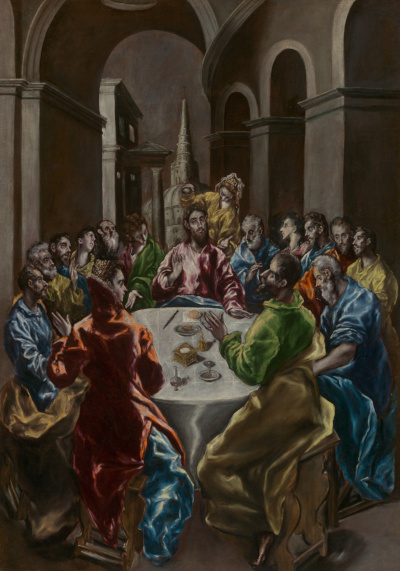This painting arrived towards the end of El Greco's career and is loosely dated at around 1608–14. It features all of the signature style for which we are so familiar, but many elements of this only appeared later on in his career.
Many elements of this painting capture the essence of the artist, though the imposing architectural structure in the background is much more akin to his earlier work whilst in Crete and then Italy. Once El Greco switched to Spain one would not see elements of architecture particularly often, or at least not in this manner. He did produce plenty of cityscapes, where buildings were viewed from afar, but tended to leave scenes of pillars and internal structures out of his compositions. The coloured clothing in the foreground also connects to his life in Italy, with the influence of Venetian art bringing about these bright tones. They remained throughout his career and was one Italian influence that survived his move to Spain. El Greco continually wanted to evolve his work and managed to fuse many of the best elements of Italian and Spanish art together to produce a winning formula.
Within The Feast in the House of Simon we find the figures all around a table, deep in conversation with lively expressions and a packed room. Light is centered around the table, illuminating the faces of the figures closest to us, whilst leaving the rest of the scene fairly dark. A scene such as this would normally be completed in landscape dimensions in order to adapt to the width of the table but in this example the Greek painter chooses to make the painting tall and narrow, leaving space for the buildings in the upper part of the painting. He was always a unique and alternative artist yet still managed to achieve considerable success within his own lifetime. Parts of The Feast in the House of Simon are believed to have been completed by members of his studio, as suggested by the slight variety in how the different faces are styled.
At the time of writing, the painting is on display in the Painting and Sculpture of Europe Gallery, at the Chicago Art Institute. It is one of the few El Greco paintings to exist outside Europe, though there are also a number of other artworks which are connected to his studio, which included his son. The Chicago gallery actually hold five artworks in total from his career, including The Assumption of the Virgin, 1577–79, Saint Francis Kneeling in Meditation, about 1595–about 1600, Saint Martin and the Beggar, about 1597–about 1600 and also a drawing by the name of Painting of the Virgin Mary ascending to heaven amongst multitude of angels. There are actually few few El Greco drawings left today, making this a valuable entry, and the other paintings to be found here are also amongst his finest creations.




